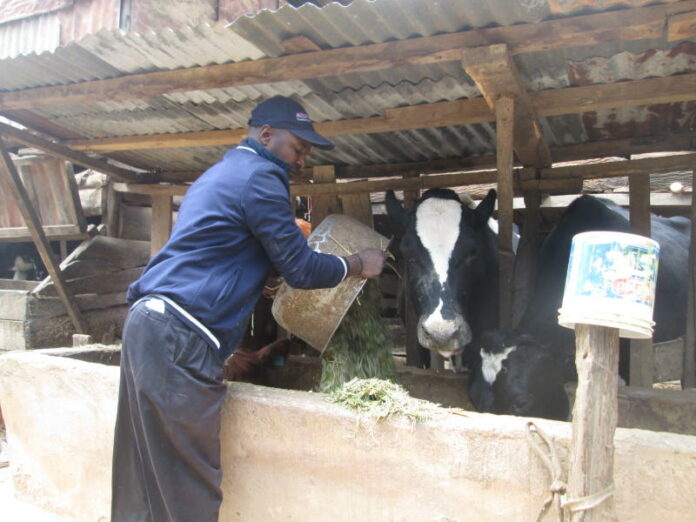How to Formulate Dairy Rations: In formulating a ration for dairy cows to achieve high levels of milk production, one should aim at providing a diet that contains all nutrients required by farm animals. Energy, proteins and minerals are the three essential feed ingredients that are required by the animal for growth, maintenance and for production in terms of milk and/or pregnancy. These are generally recognized first in feed rationing. Other ingredients include vitamins. These should be availed in the required levels for normal functioning of the dairy cow and support milk production.
Ideally the farmer should provide the cow with home grown feeds to meet its maintenance requirements and any additional nutrients for production should be obtained from concentrates.
Due to the high costs of bought feeds, the farmer should as much as possible strive to make use of home grown feeds. Well prepared hay, maize meal, napier grass, legumes and crop byproducts such as sunflower heads with seed, maize stover/cobs and sweet potato vines can be used in formulating balanced rations on the farm thereby reducing the cost of feeding.
Factors to consider in ration formulation
1. Acceptability to the animal. The ration being formulated has to be palatable enough to stimulate intake by the animal. Feed refused by the animal is worthless.
2. Digestibility. The nutrients in the feed have to be digested and released into the gastrointestinal tract to be utilized by the animal.
3. Cost. The least-cost ration should ensure that all requirements of the animal are met and the desired objectives are achieved.
4. Presence of anti-nutritional factors and toxins. Anti-trypsin factor in soybean meal, affects the digestion of some nutrients by making them unavailable to the animal. Some feed ingredients may also contain toxic substances, which may be detrimental to the animal when given in excessive amounts. The inclusion of these feed ingredients should therefore be limited or eliminated from the formulation.
Double M bus company, its Jogoo Road land to be auctioned
Energy sources
These include maize, barley, oats and sorghum. By products are also used as energy e.g. bran, pollard, maize and rice polishing.
Protein sources
Include fishmeal, cottonseed cake, ground nut cake, sunflower cake and coconut oil cake.
Basal feed
This constitutes the bulk of what the animal eats, are generally roughages and can be categorized as those relatively high in proteins e.g. Lucerne, herbaceous legumes such as Desmodium and fodder trees such as Leucaena, Calliandra, Sesbania and Gliricidia; and those low in protein such as napier grass, sweet potato vines, cassava leaves and maize leaves.
Commercial supplements
These are either protein or energy concentrates generally low in fibre. The protein sources are mainly derived from oil seeds e.g. cotton seed, groundnut seed, and soyabean seed cakes. Energy sources are derived from cereal and cereal by-products e.g. maize and wheat bran / germs and rice bran. Others are urea, molasses and mineral supplements.
Methods in ration formulation
Home made rations are formulated from feed resources which are locally available within the farm or can be cheaply bought. Once you identify the most cost effective feed materials which can satisfy the nutrient requirements of the dairy cow, the next step is to combine the feeds in such ratios as to minimize costs and optimize the nutrient composition of the resulting diet.
There are several methods of determining the quantities to mix. These include:-
- The Pearson square – used when the number of feed types is two or at most four. It becomes cumbersome when the number of feed ingredients is higher.
- Simultaneous equation – appropriate when mixing more than two ingredients to formulate the feed.
- Computer programs – used for complex mixing where several ingredients are involved.
Energy and protein are more often than not the most limiting nutrients and therefore the most critical and the object is to know the energy and protein content of the feed ingredients. The desired energy and protein levels of the resultant feed mixture become the focal point in the calculations. Other supplements like minerals and vitamins as well as feed additives such as antibiotics can be added. The chemical composition of the various feed ingredients at your disposal therefore becomes very important.
The next critical object is to know the nutrient requirements of the animal you wish to feed. For example nutrient requirements for heifer are less demanding compared to a lactating cow. If in doubt you can seek advice from animal nutritionists or consult tables on feeding standard for different categories of livestock available from the Kenya National Bureau of Standards or the National Research Council.
The use of two or three cheaply available farm feed materials to formulate a ration is by far the most cost effective way to increase production and profits within a dairy farm. Currently there are feed formulators who use computer programs and complex matrices to arrive at precise quantities of various feedstuff required to make a diet of desired protein, energy and mineral levels. These can help the farmers to use the various feed materials within the farm to make a ration for their animals
The feedstuff so used to compound a ration should be mixed homogeneously to have a uniform diet. In the absence of a mechanical mixer, the farmer should first measure the required amounts then mix a small amount and adding small quantities at a time all the while mixing thoroughly. Have the diet in the optimum texture so that the animal eats with ease.








